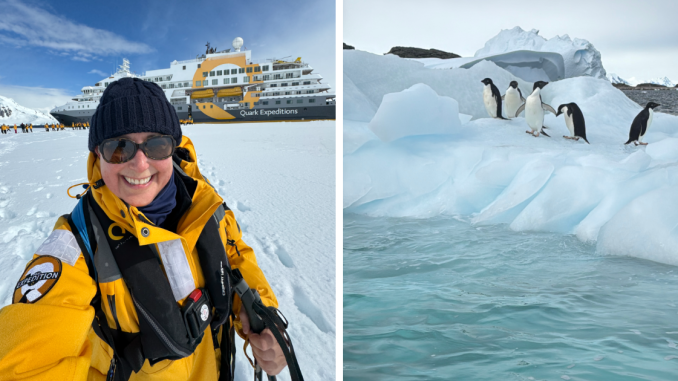
Very few places on Earth feel truly untouched. Antarctica is one of them. It’s the coldest, driest, and windiest continent, yet it draws travelers who are curious, determined, and ready to be humbled.
In all of human history, only about 800,000 people have ever visited Antarctica. Even fewer, around 100,000, have crossed south of the Antarctic Circle. To step foot here is to join a very small chapter of human experience.
This journey marked my seventh continent, a milestone I had dreamed of for years. I traveled with Quark Expeditions, a leader in polar travel. From the start, it was clear — this wasn’t a cruise. It was an expedition. Each day was shaped by weather, ice, wildlife, and science. Nothing was scripted. The adventure unfolded moment by moment. That was the magic.
More info: lisaniver.com | Facebook | Instagram | youtube.com
Antarctica became the most remarkable classroom I’ve ever known
On board, our days alternated between outdoor exploration and lectures from experts in glaciology, ornithology, marine biology, and polar history. I’ve sat in classrooms all over the world, but learning about climate systems while surrounded by the glaciers we were studying felt entirely different. Our lecturers didn’t just teach — they connected the dots. They showed us how Antarctic currents influence global temperatures, how krill sustain nearly every species here, and why the ice shelves matter to all of us — not just scientists.
One of my favorite sessions was about penguins. Antarctica is home to several species, but three in particular shaped our landings: gentoo, adelie, and chinstrap. I used to think of penguins as almost cartoonish, but watching them navigate their daily lives made them feel like heroes in their own epic story.
Gentoos, with their bright orange bills and curious personalities, often waddled right up to us — close enough to look, never to touch.
Adelies were pure energy, moving with constant purpose, as if they were always running late.
Chinstraps looked perfectly formal, their sleek black line across the chin like a tuxedo for an Antarctic gala.
They weren’t just cute, they were resilient, strategic, and deeply adapted to one of the harshest environments on Earth.
The small boat journeys showed me how vast Antarctica really is
Every time we went ashore, we traveled by Zodiac — small, sturdy inflatable boats that carried us between the ship and the ice. Zodiac life quickly developed its own rhythm: boots on, life jacket clipped, gloves secured, camera ready, step, sit, slide into place.
Sometimes we’d cruise past towering blue icebergs that shifted in the light like stained glass. Other times we’d land, walking across ice and rock to watch penguin colonies, observe seals resting on ice floes, or simply stand still and gaze at the horizon.
The landscape defies scale. What looks like a hill is actually a mountain. What looks like a piece of ice you could toss is the size of a building. There are no trees, no roads, no power lines — nothing to compare against except your own memory of how big the world usually feels.
Here, perspective resets.
Standing on the Antarctic circle was probably the most surreal moment of my life
Crossing the Antarctic Circle — 66°33′ south — felt like an initiation. Only about 100,000 travelers have ever gone this far. The air was sharper, the silence deeper. It wasn’t eerie — just vast.
The expedition team gathered us outside as the GPS ticked past the line. We cheered, we hugged, we watched the horizon, and then it sank in: we were standing in a part of the planet most people will only ever imagine.
A tiny ship and its crew turned my Antarctic expedition into something truly extraordinary
Our ship wasn’t large, and that was crucial, because smaller expedition ships allow for more time ashore and deeper exploration.
The spaces were thoughtfully designed: windows everywhere so you never lost sight of the ice, warm gathering areas for tea and conversation, and a bridge open to visitors where we could watch navigation in real time.
The crew was the heartbeat of the journey. They guided, briefed, adapted, and kept us safe. When the weather shifted (and it always did), they seamlessly redesigned the day. When wildlife appeared, they alerted the whole ship within minutes.
Every landing felt intentional, meaningful, and safe.
Standing on the ice made me feel still, small, and very grateful
Standing with my boots on the ice, I felt something I hadn’t expected: stillness. Not the absence of movement, but the absence of noise, the kind that fills our lives without us noticing.
I realized that Antarctica doesn’t just show you new landscapes, it shows you new internal space.
My book was in the ship’s library. My feet were on the land I had dreamed of for decades. I was part of the small fraction of humans who have ever seen this place with their own eyes.
And I was grateful for every moment of it.
I believe everyone should experience Antarctica at least once
Antarctica is not a vacation. It’s a perspective shift. You don’t go to check a box — you go to understand something about the world and something about yourself.
Seeing our planet in its rawest form reminds you why it matters that we care for it.
If you have the chance to go — go. Not someday. Not “when things slow down.” Go when your curiosity calls.
Because Antarctica isn’t just a place you visit. It’s a place that stays with you.
